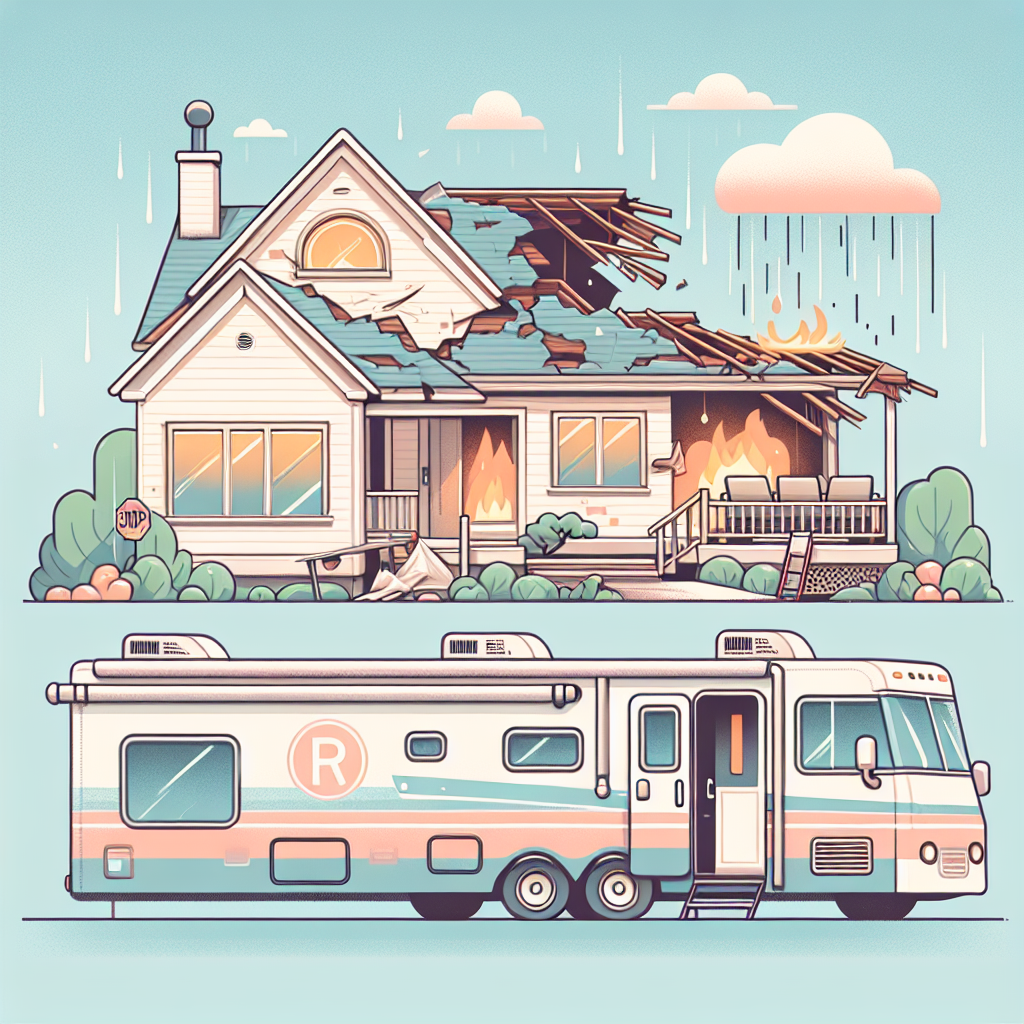Filed under Home Insurance on
What Is Loss of Use Coverage in Home Insurance Explained

If you had to move out of your home tomorrow because of a fire, burst pipe, or severe storm damage, where would you stay—and how would you pay for it? That’s exactly the moment when loss of use coverage steps in. It helps bridge the financial gap between your normal living situation and the unexpected costs of temporary displacement, so you can focus on getting life back on track rather than scrambling to cover hotel nights and extra meals.
Loss of Use Coverage, in Plain English
In most homeowners policies, loss of use coverage—often called Coverage D or Additional Living Expense (ALE)—pays for the reasonable increase in your living costs if a covered peril makes your place uninhabitable. It can also reimburse landlords for lost rental income and may apply when civil authorities bar access to your home due to nearby damage. If you’ve ever wondered “What Is Loss of Use Coverage in Home Insurance Explained,” this guide breaks down what it pays for, when it applies, and how to get every eligible dollar you’re owed.
The Three Parts You Should Know
- Additional Living Expense (ALE): Reimburses the extra costs of maintaining your household’s normal standard of living while you can’t live at home. Think hotel stays, temporary rentals, increased food costs, laundry, and pet boarding.
- Fair Rental Value (FRV): If you rent part or all of your home to others and it becomes uninhabitable due to a covered loss, this pays the lost rental income for the period of repair.
- Civil Authority Prohibits Use: If government authorities restrict access to your home due to nearby damage from a covered peril, your policy may cover the associated additional living expenses for a limited time.
When Loss of Use Coverage Applies
Loss of use is triggered when a covered peril under your policy—such as fire, smoke, windstorm, sudden water discharge from plumbing, or vandalism—renders your home uninhabitable. Uninhabitable generally means unsafe or unsanitary conditions that make it unreasonable to live there during repairs. The exact definition can vary by insurer and policy form, but it usually goes beyond mere inconvenience.
Worth noting: The cause matters. If the displacement stems from a peril your policy excludes (for instance, flood in a standard HO-3 without flood endorsement), loss of use coverage will not apply. Similarly, maintenance issues or gradual wear and tear aren’t covered triggers.
Common Triggers and Non-Triggers
- Covered triggers: House fire, smoke damage, lightning strike, treefall through the roof, sudden pipe burst that soaks walls and floors, or a windstorm that compromises your structure.
- Usually excluded: Flood (unless you have a separate flood policy), earth movement/earthquake (unless endorsed), long-term leaks or mold from neglect, or a planned renovation.
What Loss of Use Coverage Actually Pays For
Your policy intends to keep you at your normal standard of living—no more, no less. Reimbursement focuses on the increased costs above your typical spending. Insurers typically pay up to the policy limit, subject to reasonable and necessary expenses.
Typical Eligible Expenses
- Temporary lodging: Hotel bills, short-term rentals, extended stay suites, or corporate housing.
- Food: The extra amount you spend over your normal grocery/meal costs when you’re displaced (for example, higher restaurant spending).
- Transportation: Additional mileage or public transit if your temporary place is farther from work or school.
- Laundry and dry cleaning: Especially if you don’t have in-unit laundry at your temporary place.
- Pet boarding or pet fees: When your temporary housing can’t accommodate your animals.
- Storage: Fees to store belongings while repairs are underway.
- Utilities: Extra utilities at your temporary location and, in some cases, minimum utility costs at the damaged home if required during repairs.
- Parking and other necessary fees: If your interim housing requires paid parking or similar charges.
What It Usually Does Not Cover
- Mortgage or property taxes: You must continue paying them, though ALE can cover extra rent or hotel costs.
- Cosmetic upgrades: The policy won’t pay for premium housing beyond your normal standard of living.
- Expenses unrelated to displacement: New furniture for style, elective upgrades, or long-term lifestyle changes.
- Loss from excluded perils: If the triggering damage isn’t covered, the related ALE isn’t either.
How Much Loss of Use Coverage You Have
Many homeowners policies set loss of use coverage as a percentage of the dwelling limit—commonly 20% to 30%. For example, if your dwelling coverage is $400,000, ALE might cap at $80,000 to $120,000. Some policies specify a separate dollar limit or a time cap (e.g., 12 months). Read your declarations page and policy endorsement carefully to confirm the exact limit and duration.
Industry groups such as the Insurance Information Institute note that rising construction costs and repair timelines can stretch displacement periods, making it wise to review your limit annually. A prolonged rebuild due to supply chain delays or labor shortages can burn through an ALE limit faster than you expect.
A Quick Example
Let’s say a kitchen fire forces you out for six months while smoke remediation and reconstruction occur. Your normal monthly housing costs are $2,200 (mortgage, insurance, and taxes). During displacement, you rent a small apartment for $2,800 and spend $400 more than usual on food and laundry. Your increased monthly living cost is $1,000 ($600 extra rent + $400 extra food/laundry). Over six months, that’s $6,000. If your loss of use limit is $60,000, you’re well within the cap, and those incremental costs should be reimbursable, subject to documentation and policy terms.
How to Use Loss of Use Coverage Without Hassle
- Report the claim quickly: Contact your carrier or agent as soon as you’re displaced. Ask about authorized hotels, preferred vendors, and any pre-approval needed for larger costs.
- Confirm coverage and limits: Request a written outline of your loss of use coverage, including limits, time caps, and any special rules for civil authority situations.
- Track the difference: Insurers reimburse the increase over your normal expenses. Keep records of your typical baseline (past grocery bills, utility averages, etc.).
- Save every receipt: Hotels, meals, mileage logs, storage, laundry, pet boarding, and moving costs. Create a folder or spreadsheet to stay organized.
- Communicate changes: If repair timelines slip, update your adjuster and ask about extensions or increased limits when endorsements allow.
- Submit itemized documentation: Provide a clear, simple summary of dates, amounts, and the reason for the expense, with copies of receipts.
Common Mistakes That Reduce Payouts
- Not proving your baseline: If you can’t show your normal monthly expenses, it’s harder to demonstrate the “increase” that ALE covers.
- Choosing luxury options: Insurers expect “comparable” temporary housing, not upgrades. Keep choices reasonable and explain your rationale (proximity to school or work, similar size, pet-friendly).
- Forgetting time limits: Many policies cap ALE by time as well as dollars. Mark the end date and plan accordingly.
- Overlooking partial uninhabitability: If part of the home is livable, your insurer might limit ALE. Ask your adjuster to clarify standards for safety, sanitation, and habitability.
- Lack of documentation: Missing receipts or vague descriptions slow approvals and can lead to denials.
Renters, Condo Owners, and Landlords
Renters (HO-4)
Renters insurance typically includes loss of use coverage to help pay for extra living costs when a covered peril damages your unit. Even though you don’t own the building, displacement costs can be significant—especially in tight rental markets. Keep in mind that your coverage applies only to losses caused by perils listed in your policy.
Condo Owners (HO-6)
Condo policies generally include ALE and sometimes special provisions to coordinate with your association’s master policy. If the building is damaged, your loss of use coverage can fund temporary housing, while building repairs fall under the master policy according to its terms and your unit’s responsibilities.
Landlords (DP Policies)
Landlord policies typically offer fair rental value coverage to reimburse lost rent when a covered peril makes the property uninhabitable. If you also live in part of the property, you may have both FRV for tenant portions and ALE for your own displacement—check your policy’s structure.
How Much Loss of Use Coverage Do You Need?
There’s no one-size-fits-all answer, but a practical starting point is to estimate a realistic displacement period in your area (often 6 to 12 months for major repairs) and multiply by the incremental expenses you’d face. Look at local rental rates for comparable homes, current hotel prices, and your household’s unique needs (pets, accessibility, school district, commute).
Market realities matter. In cities with high rent and limited vacancy, temporary housing can be pricey and scarce after widespread disasters. Data from industry analysts and consumer groups suggest that construction backlogs and labor shortages have lengthened rebuilding timelines in many regions. That means your loss of use coverage must stretch further than it might have a few years ago.
Practical Sizing Tips
- Start with 20% to 30% of dwelling coverage, then adjust for local costs.
- Consider family size, pets, and special needs that may narrow your housing options.
- Ask your agent about endorsements that increase ALE limits or time frames.
- Revisit yearly—rents, hotel rates, and construction costs can change quickly.
Civil Authority Coverage: An Overlooked Lifeline
Sometimes your home isn’t damaged, but you’re barred from returning because the area is unsafe—think wildfire smoke, downed power lines, or a compromised building next door. When a covered peril causes authorities to prohibit access, many policies include a civil authority benefit. It’s usually time-limited and may have different daily or total caps. If an evacuation is ordered, keep records of dates, official notices if available, and all related expenses.
What Adjusters Look For
- Evidence the home is uninhabitable: Inspection reports, contractor notes, or official orders.
- Covered cause of loss: Confirmation that the triggering event is within policy terms.
- Reasonableness and necessity: Fair rates for hotels or rentals in your area; proximity to work, school, or medical care.
- Clear math on “extra” costs: A baseline of normal spending compared to displaced spending with receipts.
Trends Affecting Loss of Use Claims
Three forces have been shaping loss of use claims across the U.S.:
- Inflation in shelter costs: Rents and hotel rates rose in many markets, making temporary housing pricier.
- Longer rebuild timelines: Material costs, supply chain bottlenecks, and contractor shortages extend displacement periods.
- Catastrophe clustering: Severe convective storms, wildfires, and hurricanes can strain local housing supply, pushing up short-term rental rates and reducing availability.
Industry research and insurer reports consistently point to these pressures raising both the frequency and severity of ALE payouts. The takeaway: review your loss of use coverage each renewal, not just after a claim.
Frequently Asked Questions
Is loss of use coverage paid upfront or as reimbursement?
Typically, it’s reimbursement-based: you submit receipts and get repaid. Some carriers offer direct billing for hotels or advances after major disasters. Ask your adjuster what options are available.
What if I stay with friends or family?
Some policies allow a reasonable contribution toward their increased costs (like utilities or groceries). Confirm amounts and documentation requirements beforehand. Get a written agreement that outlines dates and a fair rate; keep payment records.
Will my mortgage be covered?
No. You must keep paying your mortgage, taxes, and insurance. Loss of use coverage focuses on the additional costs above your normal expenses, such as rent or hotel bills during displacement.
Can I choose a nicer temporary home than my normal one?
You can choose any option, but reimbursement is limited to costs that are reasonable and comparable to your standard of living. Going substantially above that may leave you paying the difference out of pocket.
What if repairs finish early or take longer than expected?
If repairs finish early, ALE ends when the home becomes habitable. If repairs take longer, ALE may continue until the limit or time cap is reached. Communicate delays promptly and document why they are necessary and outside your control.
Step-by-Step: Building a Strong ALE Claim File
- Create a baseline budget: Pull three months of typical expenses—rent/mortgage, groceries, utilities, transportation.
- Log displacement costs daily: Hotel rate, taxes and fees, meals, mileage, laundry, pet costs, and storage.
- Note the reason for each cost: “Hotel due to smoke odor and unsafe wiring,” “Restaurant meals because no cooking facilities,” etc.
- Keep communications: Save emails, texts, and letters from your adjuster, landlord, or contractors.
- Submit organized packets: Monthly summaries with receipts attached. This speeds approvals and reduces back-and-forth.
What to Discuss with Your Agent at Renewal
- Coverage limit and time cap: Is 20%–30% of your dwelling limit sufficient in your market?
- Endorsements: Options for extended ALE, ordinance or law coverage, or additional protections that indirectly affect ALE (like betterment for code upgrades that speed repairs).
- Catastrophe planning: How your carrier handles mass evacuations, advances, and vendor networks during disasters.
- Special circumstances: Pets, accessibility needs, home-based businesses, or large households that may require more robust loss of use coverage.
Real-World Scenarios
- Kitchen fire in a suburb: Smoke remediation and rebuild take five months. A family of four secures a two-bedroom apartment near the kids’ school. They track extra rent and increased food costs for reimbursement under loss of use coverage.
- Windstorm roof damage: The home is partially livable, but safety concerns force a complete move-out for two months. The insurer approves an extended-stay hotel with a kitchenette to keep meal costs reasonable.
- Wildfire evacuation: Civil authorities issue a two-week access ban. The policy pays for hotel and meals during the order’s duration, subject to the civil authority time limit.
- Landlord duplex: A covered pipe burst displaces the downstairs tenant. The owner receives fair rental value until the unit is habitable again, and ALE for their own upstairs unit if it’s also uninhabitable.
Key Takeaways
- Loss of use coverage is designed to keep your household’s standard of living intact by paying the extra costs of displacement after a covered loss.
- It typically includes Additional Living Expense, Fair Rental Value, and civil authority benefits.
- Know your limits and time caps—extended rebuild timelines and higher rental costs can exhaust benefits quickly.
- Documentation is everything: establish a baseline, save receipts, and present clear explanations for each expense.
- Revisit your coverage annually to match local market conditions and household needs.
Final Word
In a crisis, few protections feel as immediately helpful as loss of use coverage. It transforms a stressful displacement into a manageable detour by reimbursing the real, measurable increases in your living costs. If you came here seeking clarity—What Is Loss of Use Coverage in Home Insurance Explained—remember this: It’s the financial bridge that keeps life moving when your home can’t. Review your policy, verify limits, and speak with your agent about endorsements that strengthen your safety net. With the right preparation, you’ll have both the plan and the budget to weather the unexpected.
Before you close this tab, take five minutes to check your declarations page. Confirm the limit and any time constraints on loss of use coverage, make a quick list of local temporary housing options, and create a simple template for tracking expenses. Those small steps can make a big difference if you ever need to put this valuable protection to work.



